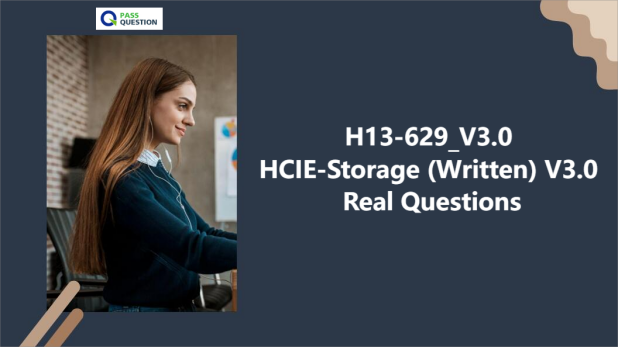H13-629_V3.0 HCIE-Storage (Written) V3.0 Real Questions
Good news! PassQuestion now provides the most up-to-date H13-629_V3.0 HCIE-Storage (Written) V3.0 Real Questions, which have been meticulously curated to cover all the exam objectives in great detail. This comprehensive coverage ensures that you are thoroughly prepared for every aspect of the exam, leaving no stone unturned. By dedicating time to studying these H13-629_V3.0 HCIE-Storage (Written) V3.0 Real Questions, you will not only enhance your understanding of the subject matter but also refine your test-taking skills to perfection. This well-rounded preparation will significantly boost your confidence, equipping you with a much better chance of passing your HCIE-Storage H13-629_V3.0 exam successfully on your very first attempt.

HCIE-Storage V3.0 Certification
To excel in the HCIE-Storage V3.0 exam, candidates need to have a good command of key technical principles, planning and design processes, deployment implementation methods and tools, advanced O&M management, and troubleshooting of typical storage solutions, such as storage data backup and storage data migration. They should be able to design, manage, build, and develop high availability storage solutions, making them competent to become storage solution experts, storage architects, and other related positions. The certification is aimed at individuals who aspire to become experts in the storage industry, including data center storage system architects, ICT professionals, and Huawei channel engineers. It is recommended that candidates master the knowledge and skills of HCIA and HCIP in the storage domain and have at least five years of relevant working experience.
Exam Information
Exam Code: H13-629
Exam Name: HCIE-Storage (Written)
Exam Type: Written examination
Exam Format: Single-answer Question,Multiple-answer Question,True or false,Short Response Item,Drag and Drop Item
Time: 90min
Passing Score/Total Score: 600/1000
Exam Cost: 300USD
Language: Chinese,English
Exam Knowledge Content
Module 1: Data Storage Technologies 20%
1. Flash Storage Technology Presentation
2. Data Protection Technology Presentation
3. Scale-Out Storage Technology Presentation
4. Hyper-Converged Infrastructure Technology Presentation
Module 2: Data Protection Solution 50%
1. Data Protection Basics
2. Backup Solution
3. Active/Standby DR Solution
4. Active-Active DR Solution
5. Geo-Redundant 3DC DR Solution
6. Data Protection Solution Planning and Design
Module 3: Data Migration Solution 10%
1. Data Migration Basics
2. Migration Solution Planning and Design
Module 4: Data Storage Management and O&M 20%
1. Huawei Data Management System
2. Data Storage Management and O&M Practices
3. Storage System Troubleshooting
View Online HCIE-Storage (Written) V3.0 H13-629_V3.0 Free Questions
1. Which of the following does not cause value-added service faults?
A. The replication links between storage devices are inconsistent.
B. LUNs are disconnected unexpectedly.
C. Logging in to a remote storage device through a serial port fails.
D. A storage pool of a remote storage device goes offline.
Answer: C
2. A company plans to deploy a disaster recovery (DR) system and requires that services run without interruption and service data be not lost when a data center-level fault occurs. The company plans to use a two-city three-DC geo-redundant architecture. Which of the following solutions meets the requirements?
A. Local HA architecture based on an active-passive mode.
B. Geo-redundant architecture based on a two-DC active-passive mode.
C. Geo-redundant architecture based on a two-DC mutual backup mode.
D. Geo-redundant architecture based on a two-DC active-active mode.
Answer: D
3. A company purchases a Huawei hybrid flash storage system. Hosts are connected to the storage system through Fibre Channel switches. Which of the following is the optimal configuration during Fibre Channel switch configuration planning?
A. Each zone contains only one host port and one storage port.
B. Each host requires only one optical fiber port to connect to a switch.
C. All ports of each Fibre Channel switch are in the same zone.
D. High-end Fibre Channel switches are always used to ensure network performance.
Answer: A
4. Huawei all-flash storage devices must be planned and designed before deployment. Which of the following does not need to be planned during storage networking?
A. Management network
B. Service network
C. IP address
D. Heartbeat network
Answer: D
5. Huawei all-flash storage systems automatically add all Ethernet and bond ports in a single cluster to a failover group. What is the name of this group?
A. Default failover group
B. VLAN failover group
C. User-defined failover group
D. Ethernet port failover group
Answer: A
6. Which of the following statements is incorrect about the protocol layer of Huawei scale-out storage products?
A. The block service supports the iSCSI protocol.
B. The object service supports access through $3/Swift.
C. The protocol layer supports access through HDFS.
D. The protocol layer does not support file access through NFS.
Answer: D
7. Before storage delivery, engineer A cannot find LUNs on a Linux service host. Which of the following are possible causes for this?
A. A storage pool is faulty.
B. A link is faulty.
C. Zones are incorrectly configured.
D. No multipathing software is installed on the host.
Answer: ABC
8. Which of the following are supported by the inspection function of Huawei OceanStor SmartKit?
A. Providing check criteria and repair suggestions.
B. Sending inspection reports by email.
C. Checking service status before an upgrade.
D. Scheduled inspection.
Answer: ABC
9. DME supports proactive O&M powered by the Al engine and policy engine. Which of the following functions can be implemented on the DME platform?
A. Performance check and prediction
B. Availability check and prediction
C. Capacity check and prediction
D. Configuration check
Answer: ABCD
10. A bank sets up two active-active data centers to carry Internet services. During system tests, storage engineers analyze the test information. Which of the following features of the Internet services match the OLTP application model?
A. Each I/O is small, ranging from 2 KB to 8 KB.
B. Data on disks is randomly accessed.
C. At least 30% of data is written randomly.
D. Redo logs are written frequently.
Answer: ABCD
- TOP 50 Exam Questions
-
Exam
All copyrights reserved 2025 PassQuestion NETWORK CO.,LIMITED. All Rights Reserved.

